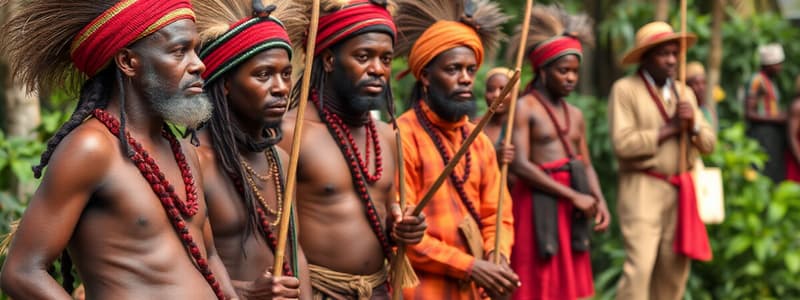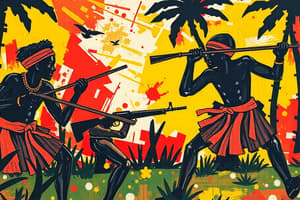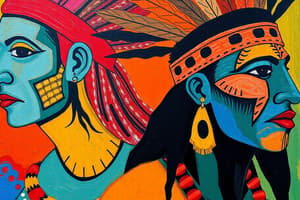Podcast
Questions and Answers
What strategic advantage did the mountainous terrain offer to the Maroon communities in Jamaica?
What strategic advantage did the mountainous terrain offer to the Maroon communities in Jamaica?
- Direct communication lines with other Maroon settlements across the island.
- A landscape similar to England, helping them feel more at home.
- Easier access to coastal trade routes for economic activities.
- Natural protection from British forces and suitable conditions for farming. (correct)
How did the treaty signed by Cudjoe impact the relationship between the Maroons and the British authorities?
How did the treaty signed by Cudjoe impact the relationship between the Maroons and the British authorities?
- It led to immediate integration of Maroon communities into the broader Jamaican society.
- It solidified the Maroons' complete independence from British rule.
- It granted the British military access to Maroon territories for resource extraction.
- It required the Maroons to return new runaway slaves in exchange for peace and autonomy. (correct)
In what way did Nanny contribute to the Maroon resistance against the British?
In what way did Nanny contribute to the Maroon resistance against the British?
- She focused on agricultural innovations to improve food production in Maroon settlements.
- She primarily served as a diplomat, securing alliances with other rebel groups.
- She provided strategic military advice and spiritual leadership to her community. (correct)
- She negotiated trade agreements with neighboring Spanish colonies.
What key factor differentiated the Sam Sharpe Rebellion from earlier slave uprisings in Jamaica?
What key factor differentiated the Sam Sharpe Rebellion from earlier slave uprisings in Jamaica?
What critical weakness hindered the success of the Sam Sharpe Rebellion?
What critical weakness hindered the success of the Sam Sharpe Rebellion?
How did the Sam Sharpe Rebellion contribute to the broader anti-slavery movement despite its ultimate failure?
How did the Sam Sharpe Rebellion contribute to the broader anti-slavery movement despite its ultimate failure?
What was Tacky's primary objective in initiating his rebellion?
What was Tacky's primary objective in initiating his rebellion?
What initial advantage did Tacky's Rebellion have over the British forces?
What initial advantage did Tacky's Rebellion have over the British forces?
Besides seizing arms, what other factor contributed to the initial success of Tacky's Rebellion?
Besides seizing arms, what other factor contributed to the initial success of Tacky's Rebellion?
What common thread connects Nanny, Cudjoe, Sam Sharpe, and Tacky in the context of Jamaican history?
What common thread connects Nanny, Cudjoe, Sam Sharpe, and Tacky in the context of Jamaican history?
How did slave laws in Jamaica contribute to the perpetuation of slavery?
How did slave laws in Jamaica contribute to the perpetuation of slavery?
How did the Maroons' use of guerilla warfare tactics impact their resistance against the British?
How did the Maroons' use of guerilla warfare tactics impact their resistance against the British?
What was the purpose of the abeng in Maroon communities?
What was the purpose of the abeng in Maroon communities?
Which of the following best describes the relationship between Maroon settlements and runaway slaves after the signing of Cudjoe's treaty?
Which of the following best describes the relationship between Maroon settlements and runaway slaves after the signing of Cudjoe's treaty?
Which of the following factors contributed most significantly to the defeat of Tacky's Rebellion?
Which of the following factors contributed most significantly to the defeat of Tacky's Rebellion?
The Sam Sharpe Rebellion is also known as:
The Sam Sharpe Rebellion is also known as:
Which Maroon leader signed a peace treaty with the English in 1739?
Which Maroon leader signed a peace treaty with the English in 1739?
What was Samuel Sharpe's role in the rebellion he led?
What was Samuel Sharpe's role in the rebellion he led?
Where did Tacky's Rebellion begin?
Where did Tacky's Rebellion begin?
Between what years did Tacky's Rebellion occur?
Between what years did Tacky's Rebellion occur?
Flashcards
Who were the Maroons?
Who were the Maroons?
Descendants of runaway slaves who established communities in the mountainous regions of Jamaica.
Why mountains?
Why mountains?
Maroons strategically located their settlements in mountainous areas for natural protection, fresh water, fertile soil, and a cooler climate.
Maroon warfare tactics?
Maroon warfare tactics?
Guerilla warfare tactics including camouflage, traps, surprise attacks, and sabotage.
What is Abeng?
What is Abeng?
Signup and view all the flashcards
Notable Maroon leaders?
Notable Maroon leaders?
Signup and view all the flashcards
Cudjoe's treaty demands?
Cudjoe's treaty demands?
Signup and view all the flashcards
Who was Samuel Sharpe?
Who was Samuel Sharpe?
Signup and view all the flashcards
Start of Sam Sharpe Rebellion?
Start of Sam Sharpe Rebellion?
Signup and view all the flashcards
Sam Sharpe Rebellion's impact?
Sam Sharpe Rebellion's impact?
Signup and view all the flashcards
Sam Sharpe Rebellion's failures?
Sam Sharpe Rebellion's failures?
Signup and view all the flashcards
Who was Tacky?
Who was Tacky?
Signup and view all the flashcards
Tacky's Rebellion tactics?
Tacky's Rebellion tactics?
Signup and view all the flashcards
Factors of Tacky's success?
Factors of Tacky's success?
Signup and view all the flashcards
Forms of resistance?
Forms of resistance?
Signup and view all the flashcards
Importance of leaders?
Importance of leaders?
Signup and view all the flashcards
Outcomes of rebellions?
Outcomes of rebellions?
Signup and view all the flashcards
Study Notes
- The text details resistance to slavery in Jamaica through the stories of the Maroons and rebellions led by Sam Sharpe and Tacky.
The Maroons
- Maroons descended from runaway slaves who formed communities in Jamaica's mountainous regions.
- Maroon settlements were strategically located in mountainous areas providing natural protection, fresh water, fertile soil, and a cooler climate for farming.
- Maroons used guerilla warfare tactics to resist the British, including camouflage, traps, surprise attacks, and sabotage.
- They used look-out points and the abeng, a signaling system using cow horns.
- Maroons constantly harassed the British through warfare.
- Nanny and Cudjoe were notable Maroon leaders.
- Nanny offered strategic advice and spiritual leadership.
- Cudjoe, who led the Trelawny Maroons, signed a peace treaty with the English in 1739.
- Cudjoe's treaty required the Maroons to return new runaway slaves.
- Maroon settlements locations included Trelawny Town, Accompong, and Nanny Town.
Sam Sharpe Rebellion
- The Sam Sharpe Rebellion, or Christmas Rebellion, occurred in St. James, Jamaica, in 1831.
- Samuel Sharpe was an enslaved Baptist deacon who organized a widespread strike demanding wages.
- The rebellion began with the burning of the Kensington Estate Great House, spreading to other parishes.
- The government suppressed the rebellion with better-trained and armed troops.
- The rebellion demonstrated the enslaved people's willingness to fight for freedom, and fueled the abolition movement.
- The rebellion suffered from a lack of leadership, training, organization, and communication among the slaves.
Tacky's Rebellion
- Tacky's Rebellion occurred between 1760 and 1761.
- Tacky aimed to overthrow the whites and establish a black-ruled colony.
- Tacky and his followers took over estates in St. Mary, raided a fort for weapons, and attacked plantations.
- The rebellion spread to other parishes.
- The rebellion was defeated, Tacky was killed, and many rebels were executed or further enslaved.
- The rebels initially overpowered British forces to seize arms and ammunition.
- The rebellion's successes were due to the speed of the initial assault, the number of slaves who joined, the commitment of the fighters, and the military skills of some rebels.
General Themes
- Forms of Enslaved People's Resistance Include guerilla warfare and organized rebellions.
- Strong leaders like Nanny, Cudjoe, Sam Sharpe, and Tacky were crucial in organizing and directing resistance efforts.
- Rebellions often faced suppression, but played a significant role in challenging slavery and contributing to the fight for emancipation.
- Slave laws existed in Jamaica, forming the legal framework that maintained enslavement.
Studying That Suits You
Use AI to generate personalized quizzes and flashcards to suit your learning preferences.



